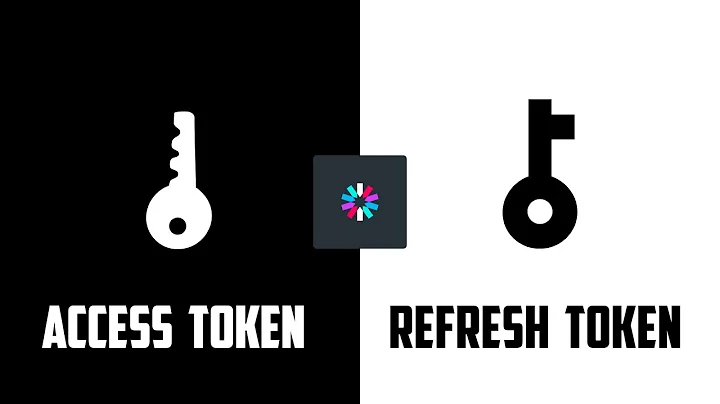What is the purpose of a "Refresh Token"?
Solution 1
Basically, refresh tokens are used to get new access token.
To clearly differentiate these two tokens and avoid getting mixed up, here are their functions given in The OAuth 2.0 Authorization Framework:
- Access tokens are issued to third-party clients by an authorization server with the approval of the resource owner. The client uses the access token to access the protected resources hosted by the resource server.
- Refresh Tokens are credentials used to obtain access tokens. Refresh tokens are issued to the client by the authorization server and are used to obtain a new access token when the current access token becomes invalid or expires, or to obtain additional access tokens with identical or narrower scope.
Now, to answer your question on why you were still being issued a refresh token instead of just securing an access token, the main reason provided by Internet Engineering Task Force in Refresh tokens is:
There is a security reason, the
refresh_tokenis only ever exchanged with authorization server whereas theaccess_tokenis exchanged with resource servers. This mitigates the risk of a long-lived access_token leaking in the "an access token good for an hour, with a refresh token good for a year or good-till-revoked" vs "an access token good-till-revoked without a refresh token."
For a more detailed and complete information of OAuth 2.0 Flow, please try going through the following references:
- OAuth 2.0 Flow: Server-side web apps
- The OAuth 2.0 Authorization Framework issued by Internet Engineering Task Force (IETF)
- SO post - Why Does OAuth v2 Have Both Access and Refresh Tokens?
Solution 2
The refresh token serves at least two purposes. First, the refresh token is a kind of 'proof' that an OAuth2 Client has already received permission from the user to access their data, and so can request a new access token again without requiring the user to go through the whole OAuth2 flow. And second, it helps increase the whole flow of security when compared with a long lived access token. I'll touch on both of these points in a little more detail.
Refresh Tokens as a Means to Not Annoy the User
Let's talk about the first purpose with an example. Suppose you, a User, were using a third party Client web application that wanted to interact with your YouTube account data. Once you grant permission to the Client application to use your YouTube data, would you want the Client app to prompt you for your permission again when its YouTube token expired? What happens if the YouTube token expiry time was something very low, like 5 minutes. It would get a little annoying having the Client application prompt you for your permission at least every 5 minutes! The solution that OAuth2 proposes to this 'problem' is refresh tokens. By using refresh tokens, the access token can remain short-lived (which is desirable in case the access token is leaked or stolen somehow), and the refresh token can remain long(er)-lived, allowing the Client to get a new access token when one expires without requiring the user's permission (again).
But why a refresh token? If the point is to not bug the User with permission requests, then why can't the Client simply say "Hey, Authorization Server, I want another access token. Now!"? Or, "Hey Authorization Server, here is my expired token, give me a new one!". Well, the refresh token serves as a kind of "proof" that the Client at some original point in time was granted access by a User. This "proof" is in the form of the refresh token being digitally signed by the Authorization Server. By the Client presenting a refresh token, the Authorization Server can verify that the Client received, at some point in the past, permission from the User, and the Client does not have to prompt the User again.
Refresh Token as a Means to Increase Security
However, this raises the question, "Well, what happens if the refresh token is leaked or stolen, or simply kept by a malicious Client application that doesn't get rid of it at the user's request? Can't the attacker just continue to use the refresh token to gain a valid access token indefinitely (or until it expires)? This question leads to discussing the second purpose that I mentioned, of refresh tokens contributing to a more secure flow.
The issue that arises with access tokens is that, once acquired, they only ever get presented to the Resource Server (YouTube for example). So if an access token is stolen or compromised, how do you tell the Resource Server not to trust that token? Well, you can't really. The only way to do it would be to change the private signing key on the Authorization Server (the key that signed the token in the first place). I imagine this is inconvenient to do, and in some cases (like Auth0), is not supported.
On the other hand, refresh tokens need to be presented to the Authorization Server frequently, and so if one is compromised, then it is trivial to revoke or deny the refresh token as a whole, and not have to change any signing keys.
Solution 3
@Teyam mention SO post Why Does OAuth v2 Have Both Access and Refresh Tokens? but I prefer the another answer there: https://stackoverflow.com/a/12885823/254109
TL;DR refresh_token does not bring increased security. It's for the purpose to improve scalability and performance. Then, access_token may be stored just in some fast, temporary storage (like memory). It allows the authorization and resource server separation, too.
Solution 4
"So I don't see how this is any more secure than just giving me an Access Token from the start and not bothering with the whole Refresh Token system." I struggled with the same question. The short answer is the refresh token is necessary to assure the credentials have not expired.
An example may help: I have a database that stores your medical records. You consent to sharing your medical records with your spouse. Your spouse uses their Access Token to read your records from my database. Two weeks from now your spouse checks again on your medical records and the refresh token is used to ensure they still have permission (from the authentication server) to view your records. The refresh token bypasses the need for your spouse to re-enter their credentials (username and password) to the authentication server, but it does ensure they still have legitimacy to access the resource. A never expiring Access Token would not know if you had revoked your spouse's rights to access your medical records.
Solution 5
Here is the information from the OAuth 2.0 documentation.
Refresh tokens are used to obtain a new access token when the current access token becomes invalid or expires, or to obtain additional access tokens with identical or narrower scope (access tokens may have a shorter lifetime and fewer permissions than authorized by the resource owner).
+--------+ +---------------+
| |--(A)------- Authorization Grant --------->| |
| | | |
| |<-(B)----------- Access Token -------------| |
| | & Refresh Token | |
| | | |
| | +----------+ | |
| |--(C)---- Access Token ---->| | | |
| | | | | |
| |<-(D)- Protected Resource --| Resource | | Authorization |
| Client | | Server | | Server |
| |--(E)---- Access Token ---->| | | |
| | | | | |
| |<-(F)- Invalid Token Error -| | | |
| | +----------+ | |
| | | |
| |--(G)----------- Refresh Token ----------->| |
| | | |
| |<-(H)----------- Access Token -------------| |
+--------+ & Optional Refresh Token +---------------+
(A) The client requests an access token by authenticating with the authorization server and presenting an authorization grant.
(B) The authorization server authenticates the client and validates the authorization grant, and if valid, issues an access token and a refresh token.
(C) The client makes a protected resource request to the resource server by presenting the access token.
(D) The resource server validates the access token, and if valid, serves the request.
(E) Steps (C) and (D) repeat until the access token expires. If the client knows the access token expired, it skips to step (G); otherwise, it makes another protected resource request.
(F) Since the access token is invalid, the resource server returns an invalid token error.
(G) The client requests a new access token by authenticating with the authorization server and presenting the refresh token. The client authentication requirements are based on the client type and on the authorization server policies.
(H) The authorization server authenticates the client and validates the refresh token, and if valid, issues a new access token (and, optionally, a new refresh token).
Related videos on Youtube
Comments
-
Jason Axelrod almost 2 years
I have a program that integrates with the YouTube Live Streaming API. It runs on timers, so its been relatively easy for me to program in to fetch a new Access Token every 50 minutes with a Refresh Token. My question is, why?
When I authenticated with YouTube, it gave me a Refresh Token. I then use this refresh token to get a new Access Token about once an hour. If I have the Refresh Token, I can ALWAYS use this to get a new Access Token, since it never expires. So I don't see how this is any more secure than just giving me an Access Token from the start and not bothering with the whole Refresh Token system.
-
 mfaani over 4 years
mfaani over 4 years -
 jmrah almost 4 yearsAccess token are bearer tokens. Meaning no other identification is required, and the access token is all that is needed to impersonate you. Because of this, they should always remain short lived. On the other hand refresh tokens are not bearer tokens. When you send a refresh token to YouTube to get a new access token, you also have to send a client_id and client_secret. Because of this, refresh token can remain longer lived because it is much less likely that both the refresh token and the client_secret would be compromised.
jmrah almost 4 yearsAccess token are bearer tokens. Meaning no other identification is required, and the access token is all that is needed to impersonate you. Because of this, they should always remain short lived. On the other hand refresh tokens are not bearer tokens. When you send a refresh token to YouTube to get a new access token, you also have to send a client_id and client_secret. Because of this, refresh token can remain longer lived because it is much less likely that both the refresh token and the client_secret would be compromised. -
 Olle Härstedt about 2 years@jmrah Why is it less likely that the refresh token and client_secret would be compromised? All tokens, including access tokens, are send over HTTPS, I assume, so they are always encrypted.
Olle Härstedt about 2 years@jmrah Why is it less likely that the refresh token and client_secret would be compromised? All tokens, including access tokens, are send over HTTPS, I assume, so they are always encrypted. -
 jmrah about 2 years@OlleHärstedt, less likely to be compromised in two ways I guess. First, because they spend much less time being sent over the wire then access tokens - an attacker mounting a MITM attack (or some other type), has less opportunities to obtain them. Second, if an attacker was to gain some access to the server, they would need to obtain 3 pieces of information (token, id, and secret) as opposed to just one (access token), which, theoretically, seems harder to do.
jmrah about 2 years@OlleHärstedt, less likely to be compromised in two ways I guess. First, because they spend much less time being sent over the wire then access tokens - an attacker mounting a MITM attack (or some other type), has less opportunities to obtain them. Second, if an attacker was to gain some access to the server, they would need to obtain 3 pieces of information (token, id, and secret) as opposed to just one (access token), which, theoretically, seems harder to do.
-
-
huyz about 5 yearsexcept there is a security reason, as mentioned by @Teyam: "refresh_token is only ever exchanged with authorization server whereas the access_token is exchanged with resource servers"
-
Gherman over 4 yearsShould refresh token also help get new refresh token?
-
JustAMartin over 4 yearsWhy just not acquire a new short-lived access_token when it expires? Why to have the long lived refresh_token if you need to request the server for a new access_token anyway? Or is it true that with a refresh_token I don't need to maintain alive identity provider cookie and it issues new access_tokens based on the refresh_token even after the cookie has long gone and the user would have to enter his credentials if they wanted to get a new access_token?
-
 jmrah almost 4 years@JustAMartin As an OAuth2 Client, without a refresh token, I would need to initiate the whole authorization flow again (getting the user to 'login' and give me permissions again), in order to get another access token. Refresh tokens bypass this requirement as a sort of 'proof' that I, as the Client, have already received the User's permission to request an access token.
jmrah almost 4 years@JustAMartin As an OAuth2 Client, without a refresh token, I would need to initiate the whole authorization flow again (getting the user to 'login' and give me permissions again), in order to get another access token. Refresh tokens bypass this requirement as a sort of 'proof' that I, as the Client, have already received the User's permission to request an access token. -
 DaviesTobi alex almost 4 yearscan a refresh token have identical or same data as the access token? since the major use of refresh token is to ease user experience and limit hackers' access time to a resource.
DaviesTobi alex almost 4 yearscan a refresh token have identical or same data as the access token? since the major use of refresh token is to ease user experience and limit hackers' access time to a resource. -
 Arno van Lieshout over 3 yearsThis is only more secure if we assume the authorization server is somehow better secured as the resource server. If this is not the case it is actually less secure. It the refresh token is compromised I can just use that to get a new access token.
Arno van Lieshout over 3 yearsThis is only more secure if we assume the authorization server is somehow better secured as the resource server. If this is not the case it is actually less secure. It the refresh token is compromised I can just use that to get a new access token. -
 mercury over 3 yearsTL;DR ?? is it really ?
mercury over 3 yearsTL;DR ?? is it really ? -
 Krishnaraj about 3 yearsWouldn't the access token be invalid if I have revoked my spouse's rights to access my medical records even if its never expiring?
Krishnaraj about 3 yearsWouldn't the access token be invalid if I have revoked my spouse's rights to access my medical records even if its never expiring? -
Sammy Taylor almost 3 yearsThis answer focuses a lot on the "what" and very little on the "why". I think a real-world example would benefit readers.
-
 Leeish almost 3 yearsMeans to not annoy the user explained this for me. In my context I'm hitting an API from a web back-end so I never have to enter credentials manually, they are available in the application. I always wondered, why not just get a new token each time with my credentials, why store a refresh token and track its expiration. I never thought that in a user workflow where credentials are hand-entered this would be highly annoying.
Leeish almost 3 yearsMeans to not annoy the user explained this for me. In my context I'm hitting an API from a web back-end so I never have to enter credentials manually, they are available in the application. I always wondered, why not just get a new token each time with my credentials, why store a refresh token and track its expiration. I never thought that in a user workflow where credentials are hand-entered this would be highly annoying. -
 Naren almost 3 yearsaccess token are short lived usually around 30 to 60 minutes & it is highly unlikely that someone grant a client-app authorization to their data (secured resource) and revoke it within that 30-60 minutes. But if the user did revoke then the authorization server will revoke the access-token & refresh-token. Also a good client-app should also voluntarily invoke the /revoke endpoint to give up the tokens when the receiver (in this example the spouse) decides that she/he no longer needs access to the secured resources. This way no valid tokens are lying around when they are no longer needed.
Naren almost 3 yearsaccess token are short lived usually around 30 to 60 minutes & it is highly unlikely that someone grant a client-app authorization to their data (secured resource) and revoke it within that 30-60 minutes. But if the user did revoke then the authorization server will revoke the access-token & refresh-token. Also a good client-app should also voluntarily invoke the /revoke endpoint to give up the tokens when the receiver (in this example the spouse) decides that she/he no longer needs access to the secured resources. This way no valid tokens are lying around when they are no longer needed. -
1mike12 almost 3 years@Sammy Taylor completely agree. I can't believe I read that whole wall of text just to arrive at absolutely nothing
-
Benargee over 2 yearsIs it also correct to assume that because refresh tokens are used less often in requests, they are less likely to be intercepted?
-
 adir abargil over 2 yearsdissapointing....
adir abargil over 2 yearsdissapointing.... -
Teyam about 2 yearsSorry, I just answered the original question. You may want to check the other answers.
-
Bernard Wiesner about 2 yearsI like the emphasis on scalability, I think this is often missunderstood, I summarize it here: stackoverflow.com/a/71932878/8485567
-
 Vignesh S about 2 yearsI have having a doubt in the last step. Is sending refresh token using refresh token bad practise? should I not do that?
Vignesh S about 2 yearsI have having a doubt in the last step. Is sending refresh token using refresh token bad practise? should I not do that? -
Dennis Meissel almost 2 years@VigneshS I didn't get your question... If your session is about to expire, you send refresh token to get new access and refresh tokens.







